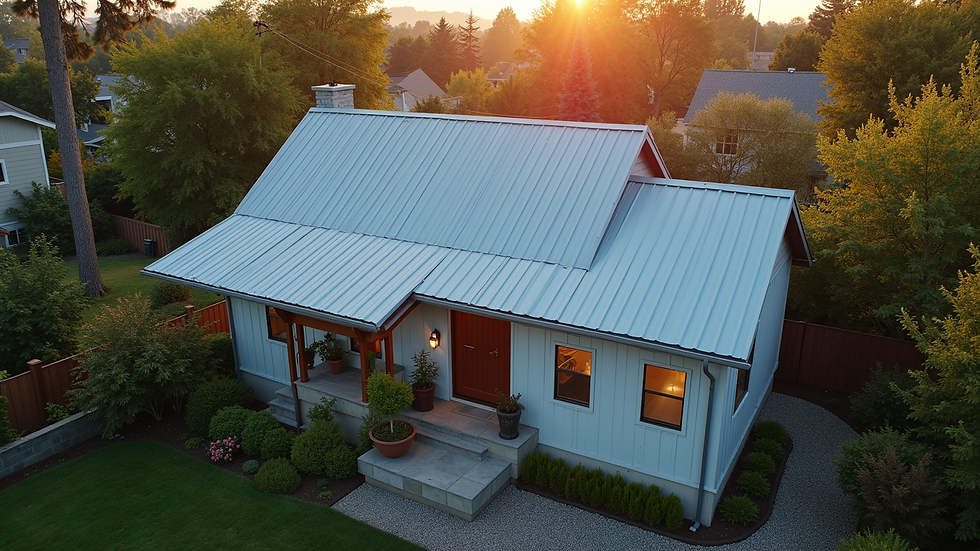Exploring the Versatile Options in Metal Roofing
- Alex Morgan

- Aug 5
- 3 min read
Metal roofing has become a popular choice for homeowners and builders alike. Its durability, energy efficiency, and aesthetic appeal make it a smart investment for any property. This article explores the various types of metal roofing, their benefits, and how to choose the best option for your needs.
Understanding Metal Roofing and Its Benefits
Metal roofing is made from various metals such as steel, aluminum, copper, and zinc. These materials are crafted into panels or shingles that protect buildings from the elements. One of the main advantages of metal roofing is its longevity. Unlike traditional asphalt shingles, metal roofs can last 40 to 70 years with proper maintenance.
Another benefit is energy efficiency. Metal reflects solar radiant heat, which can reduce cooling costs by up to 25%. Additionally, metal roofs are lightweight, making them easier to install and less stressful on the building structure.
Metal roofing is also fire-resistant, which adds an extra layer of safety. It performs well in extreme weather conditions, including heavy snow, rain, and high winds. This makes it a reliable choice for various climates.

Different Types of Metal Roofing
There are several types of metal roofing materials and styles to consider. Each has unique characteristics that suit different architectural styles and budgets.
Steel Roofing
Steel is the most common metal roofing material. It is strong, affordable, and widely available. Steel roofs are often coated with zinc or a zinc-aluminum alloy to prevent rust. They come in various finishes and colors, allowing for customization.
Aluminum Roofing
Aluminum is lightweight and resistant to corrosion, making it ideal for coastal areas where saltwater exposure is a concern. It is also easy to work with and can be painted in many colors.
Copper Roofing
Copper roofing is known for its distinctive appearance and longevity. Over time, copper develops a green patina that adds character to the roof. It is more expensive than steel or aluminum but offers excellent durability.
Zinc Roofing
Zinc is a self-healing metal, meaning scratches and minor damages repair themselves over time. It is highly durable and environmentally friendly, often used in modern architectural designs.
Metal Shingles and Panels
Metal roofing comes in two main styles: shingles and panels. Shingles mimic the look of traditional roofing materials like slate or wood shakes. Panels are larger and provide a sleek, modern appearance. Both styles offer excellent protection and can be chosen based on aesthetic preference.
For those interested in exploring more about metal roofing options, there are many resources available to help select the right material and style.

What Type of Metal Roofing Is Best?
Choosing the best metal roofing depends on several factors including budget, climate, and architectural style.
Budget: Steel is generally the most cost-effective option, while copper and zinc are premium choices.
Climate: Aluminum is excellent for coastal regions due to its corrosion resistance. Steel with protective coatings works well in areas with heavy snowfall.
Aesthetic: Copper and zinc offer unique looks that develop character over time. Steel and aluminum provide a wide range of colors and finishes.
Installation: Panels are quicker to install and often less expensive in labor costs. Shingles require more time but can enhance curb appeal.
It is important to consult with a professional roofing contractor to assess your specific needs. They can provide recommendations based on your home’s structure and local weather conditions.

Maintenance and Longevity of Metal Roofs
Metal roofs require minimal maintenance compared to other roofing materials. Regular inspections twice a year can help identify any issues early. Cleaning debris and checking for loose fasteners or damaged panels will extend the roof’s life.
Most metal roofs come with warranties ranging from 30 to 50 years. Proper installation and maintenance are key to maximizing this lifespan. Additionally, metal roofs are recyclable, making them an environmentally responsible choice.
Energy Efficiency and Environmental Impact
Metal roofing contributes to energy savings by reflecting sunlight and reducing heat absorption. This lowers cooling costs during hot months. Some metal roofs are also designed to accommodate solar panels, further enhancing energy efficiency.
From an environmental perspective, metal roofs are often made from recycled materials and can be fully recycled at the end of their life. This reduces landfill waste and the demand for new raw materials.
Final Thoughts on Metal Roofing Choices
Metal roofing offers a versatile and durable solution for protecting your home. With a variety of materials and styles available, it is possible to find an option that fits your budget and aesthetic preferences. Whether you prioritize longevity, energy efficiency, or unique design, metal roofing can meet your needs.
For those considering a new roof, exploring the full range of metal roofing options is a great first step. Professional guidance will ensure you select the best material and style for your property.
Investing in metal roofing is a smart decision that combines functionality with style, providing peace of mind for years to come.






Comments